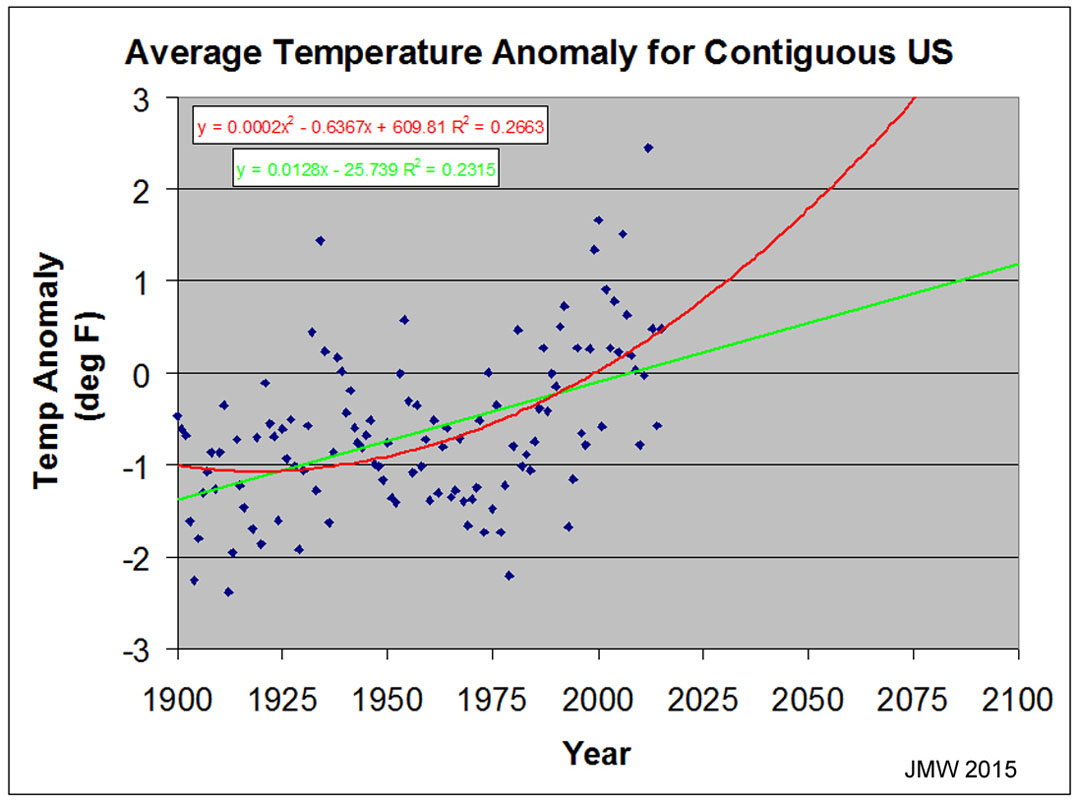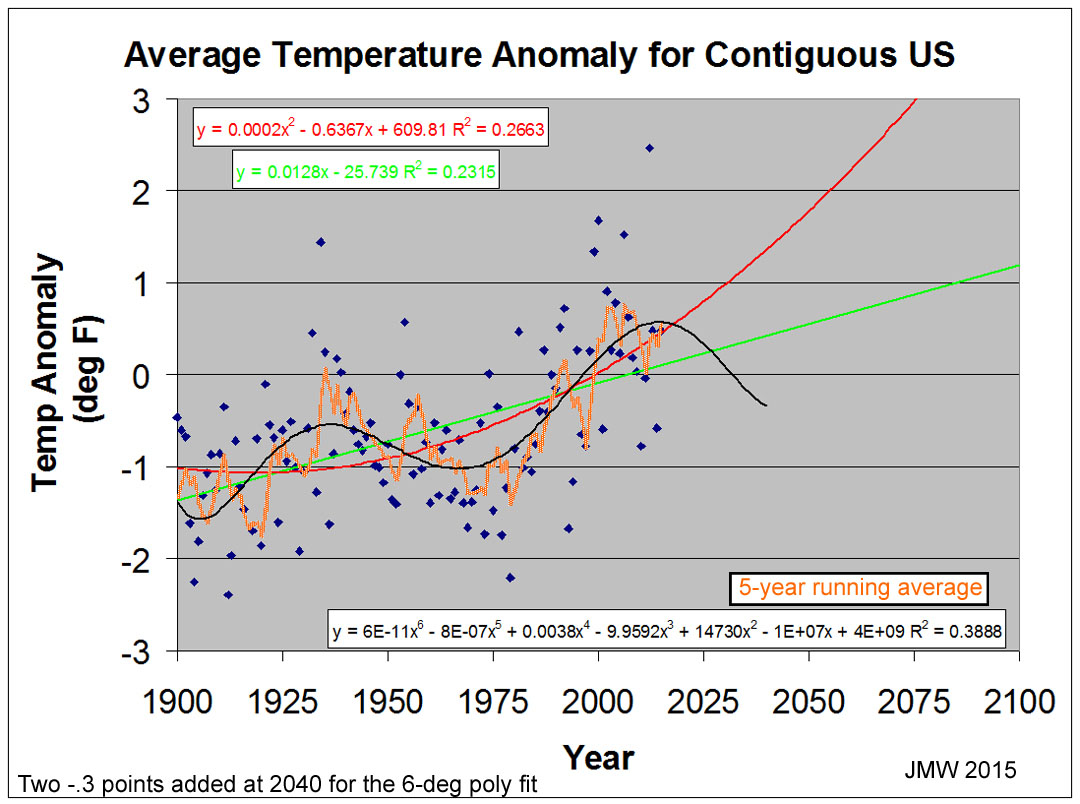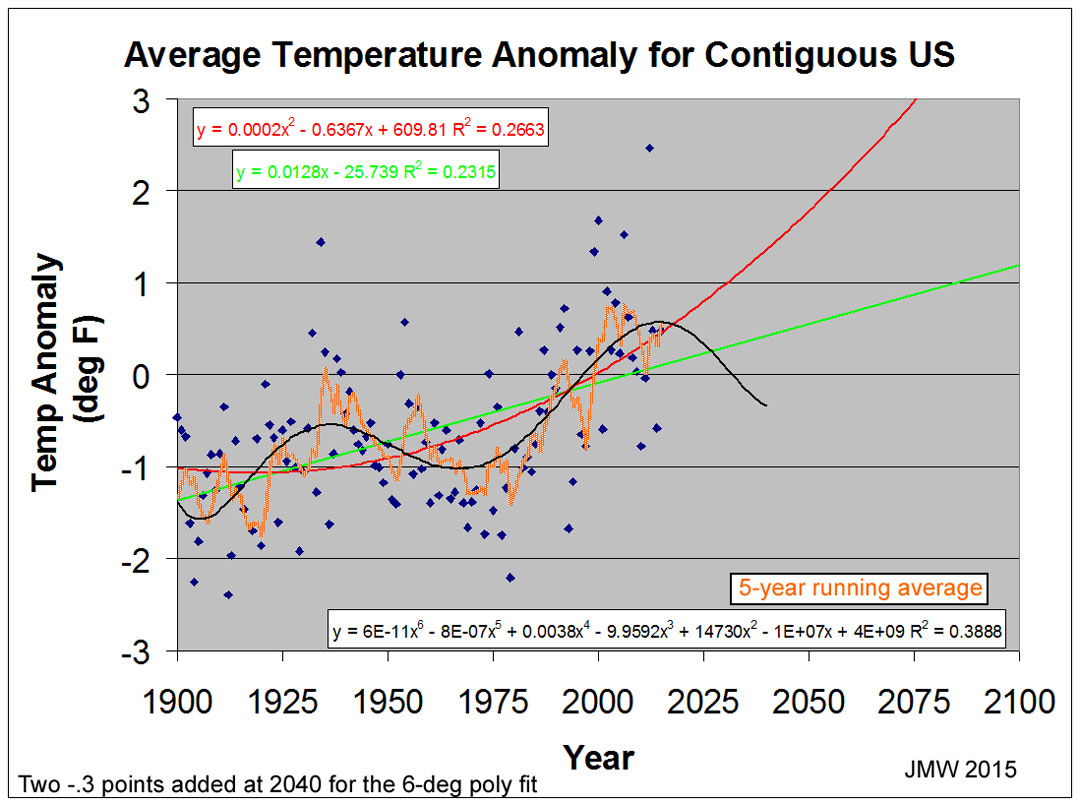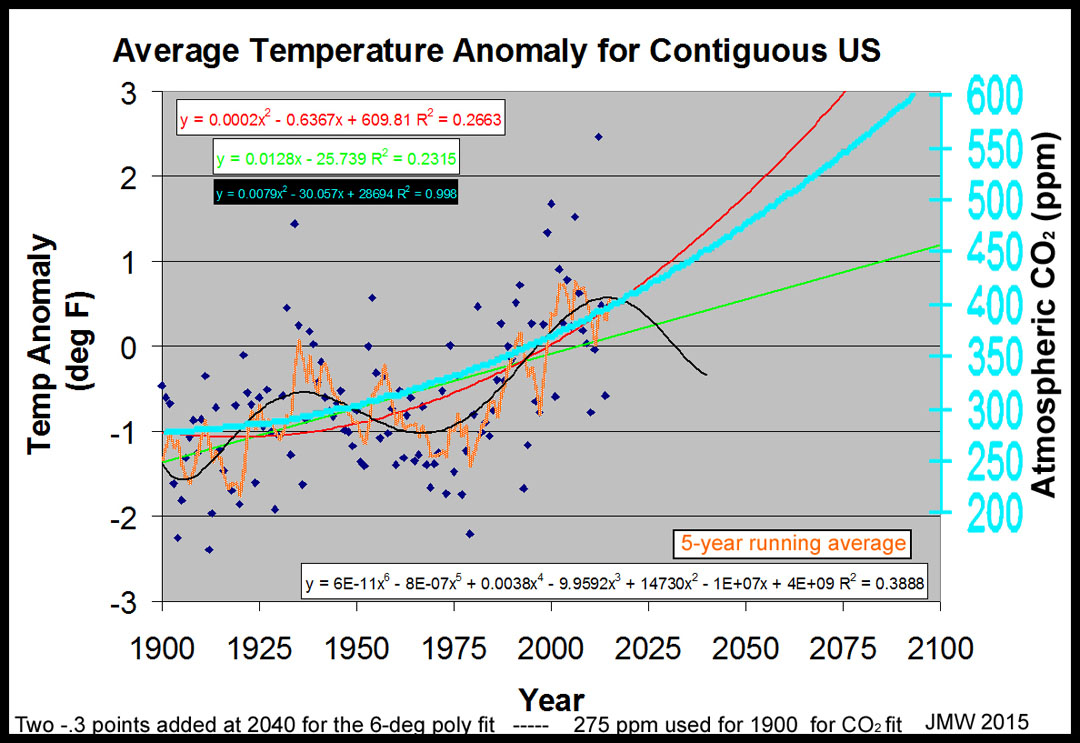Earth
Temperature Anomalies
are Not
2nd Degree Polynomial Behaviors
Joel M Williams ©2015
For
a free pdf file click here
Abstract
This article illustrates that, while the rising
level of CO2 in the atmosphere from 1900-2015 may fit a 2nd-degree
polynomial tightly (R2=0.99+) relative to time (years), the
shot-gun-appearing, annual temperatures for the contiguous US for the same
period do not. Neither a linear fit (R2=0.23) nor a 2nd-degree
polynomial fit (R2=0.27) properly characterizes the annual
temperature/time behavior. A running average clearly demonstrates cyclical
behavior of the set of annual US temperatures and that these cycles will impinge
on the temperature magnitudes expected in the future. The highly alarmist
predictions of an upward-turned, 2nd-degree, polynomial into the future are
greatly out of sync with these.
With all of the commotion about global warming, I
decided to look into the NOAA
Drought Index for the Contiguous US for the month of May for the years
1998-2015. I was struck by how extreme the changes were from year-to-year and
from region-to-region while watching the video I made. I wondered if these
changes corresponded to the average US temperature changes that occurred from
year-to-year during the same month. These data are plotted below:

When I added this info to my video, it was apparent that, while Drought Index
changes in some regions might correspond to these deviations, the climate
changes in the whole contiguous US were too great to be explained by the US
average. The exercise did provides some interesting information: 1) the average
May temperature in the contiguous US has generally declined during the past 17
years, with 2) year-to-year changes as great as 4.4°F (2.4°C); this while CO2
level increased slightly. This got me thinking again about the global warming
issue as related to the US; the US being a prime driver in global warming alarm
and analysis.
The graph on the right shows the annual (June-May, so that the current year
could be included)
anomaly
temperatures for the contiguous US from 1900-2015.
 The
first thing of note is the tremendous scatter from year-to-year! Selective
choosing of time ranges can give tremendous differences in analyses. Two
regression lines are shown for the entire set. Neither "model" shows
that the data are greatly related to the time (years) factor to which CO2 levels
can be smoothly related: R2 = 0.266 for the 2nd-deg
and 0.23 for the linear fit. Within the bounds of the years covered, the two
would hardly be deemed different with individual deviations from the
"models" reaching ±2°F. The difference between the two
"models" is in their prediction of future data! Neither treats the
"shotgun" appearing data well, in any case.
The
first thing of note is the tremendous scatter from year-to-year! Selective
choosing of time ranges can give tremendous differences in analyses. Two
regression lines are shown for the entire set. Neither "model" shows
that the data are greatly related to the time (years) factor to which CO2 levels
can be smoothly related: R2 = 0.266 for the 2nd-deg
and 0.23 for the linear fit. Within the bounds of the years covered, the two
would hardly be deemed different with individual deviations from the
"models" reaching ±2°F. The difference between the two
"models" is in their prediction of future data! Neither treats the
"shotgun" appearing data well, in any case.
Is there a way to reduce the scatter? Yes, one way
is to assume that the year-to-year data have some commonality th at
will be enhanced by a "running" average. The orange line in the figure
on the right is for a 5-year running average; a 7-year one is only slightly
different. Several things are of note:
at
will be enhanced by a "running" average. The orange line in the figure
on the right is for a 5-year running average; a 7-year one is only slightly
different. Several things are of note:
1) This data set has two major highs and lows
with minor ones in and between each.
2) Neither the linear nor the 2
nd-deg
regression duplicates the
cyclical nature of the running average.
Why would one expect linear and 2
nd
degree treatments to even be satisfactory for such co mplicated
systems, like climate changes, that are surely multidimensional? What is a
minimal polynomial equation that can treat the data and reflect the
"running average" character? The figure on the right shows the results
for a regression of the individual data (not the running average) with a 6th-degree
polynomial. R2=0.40. There is still much scatter that is unrelated to
this component, however. This model predicts that the "running
average" will be making an ~80-year downturn.
mplicated
systems, like climate changes, that are surely multidimensional? What is a
minimal polynomial equation that can treat the data and reflect the
"running average" character? The figure on the right shows the results
for a regression of the individual data (not the running average) with a 6th-degree
polynomial. R2=0.40. There is still much scatter that is unrelated to
this component, however. This model predicts that the "running
average" will be making an ~80-year downturn.
Since the major component is rather broad through
the main portion of the data, it seems likely that the region near the end of
the data set should  not
be as narrow as the 6
not
be as narrow as the 6
th-deg
polynomial indicates. To make the peak broader, two (-0.3) points have been
added (at 2040) for the regression in the figure on the right. R2=
0.39. Note that the linear regression lines goes through the inflection points
of the 6th degree
polynomial regression and, thus, indicates its slope. While it does indicate a
positive slope during this time period, it does not necessarily
"verify" cause-and-effect due to CO2 level.
The 6
th-degree
polynomial indicates that the 5-year running average behavior should be peaking
or has. There will be deviations of the running average from this polynomial
fit, but they should be small. There will be many extreme deviations of
individual (annual) data from the regression in both high AND low directions,
however, as the current data indicate "shot-gunny" character due to
OTHER factors.
A 2nd
degree polynomial fits the growth of singular-component CO2 in our
atmosphere very well: at least, until it levels or falls. The CO2
regression of the Mauna
Loa data for 1959-2014 with a 275ppm point at 1900 (R2=0.99+) is
included in the graph on the right. The CO2 scale is set so that
400ppm is the current value and then touches the linear green line. I believe
that some would simply overlay the red line. While 2nd
degree polynomial may be fine for CO2, it is not appropriate for
temperature anomalies that are multivariate. A linear regression predicts
significant positive anomalies in the future, but it is better than the 2nd
degree polynomial regression that goes exponentially upward. The latter will
continue to be extremely alarmist, even if future data to the contrary is added.
This alarm will continue until enough new data (a century's worth?) is added to
cause it to have a parabolic peak. As note before, individual annual points
should continue to be widely scattered about the 6th-degree
polynomial regression line in the future as they have in the past. The scatter
is so great that 60% of the annual temperature data does NOT even conform to
this regression! I would guess that there are many cosmic influences that
provide significant impact -- some probably even contribute to the linear
component! The
Vostok Ice Core shows many turns in the earth's global temperature; one with an
~100,000-year cycle.
Mauna
Loa data for 1959-2014 with a 275ppm point at 1900 (R2=0.99+) is
included in the graph on the right. The CO2 scale is set so that
400ppm is the current value and then touches the linear green line. I believe
that some would simply overlay the red line. While 2nd
degree polynomial may be fine for CO2, it is not appropriate for
temperature anomalies that are multivariate. A linear regression predicts
significant positive anomalies in the future, but it is better than the 2nd
degree polynomial regression that goes exponentially upward. The latter will
continue to be extremely alarmist, even if future data to the contrary is added.
This alarm will continue until enough new data (a century's worth?) is added to
cause it to have a parabolic peak. As note before, individual annual points
should continue to be widely scattered about the 6th-degree
polynomial regression line in the future as they have in the past. The scatter
is so great that 60% of the annual temperature data does NOT even conform to
this regression! I would guess that there are many cosmic influences that
provide significant impact -- some probably even contribute to the linear
component! The
Vostok Ice Core shows many turns in the earth's global temperature; one with an
~100,000-year cycle.


 at
will be enhanced by a "running" average. The orange line in the figure
on the right is for a 5-year running average; a 7-year one is only slightly
different. Several things are of note:
at
will be enhanced by a "running" average. The orange line in the figure
on the right is for a 5-year running average; a 7-year one is only slightly
different. Several things are of note: mplicated
systems, like climate changes, that are surely multidimensional? What is a
minimal polynomial equation that can treat the data and reflect the
"running average" character? The figure on the right shows the results
for a regression of the individual data (not the running average) with a 6th-degree
polynomial. R2=0.40. There is still much scatter that is unrelated to
this component, however. This model predicts that the "running
average" will be making an ~80-year downturn.
mplicated
systems, like climate changes, that are surely multidimensional? What is a
minimal polynomial equation that can treat the data and reflect the
"running average" character? The figure on the right shows the results
for a regression of the individual data (not the running average) with a 6th-degree
polynomial. R2=0.40. There is still much scatter that is unrelated to
this component, however. This model predicts that the "running
average" will be making an ~80-year downturn. not
be as narrow as the 6
not
be as narrow as the 6